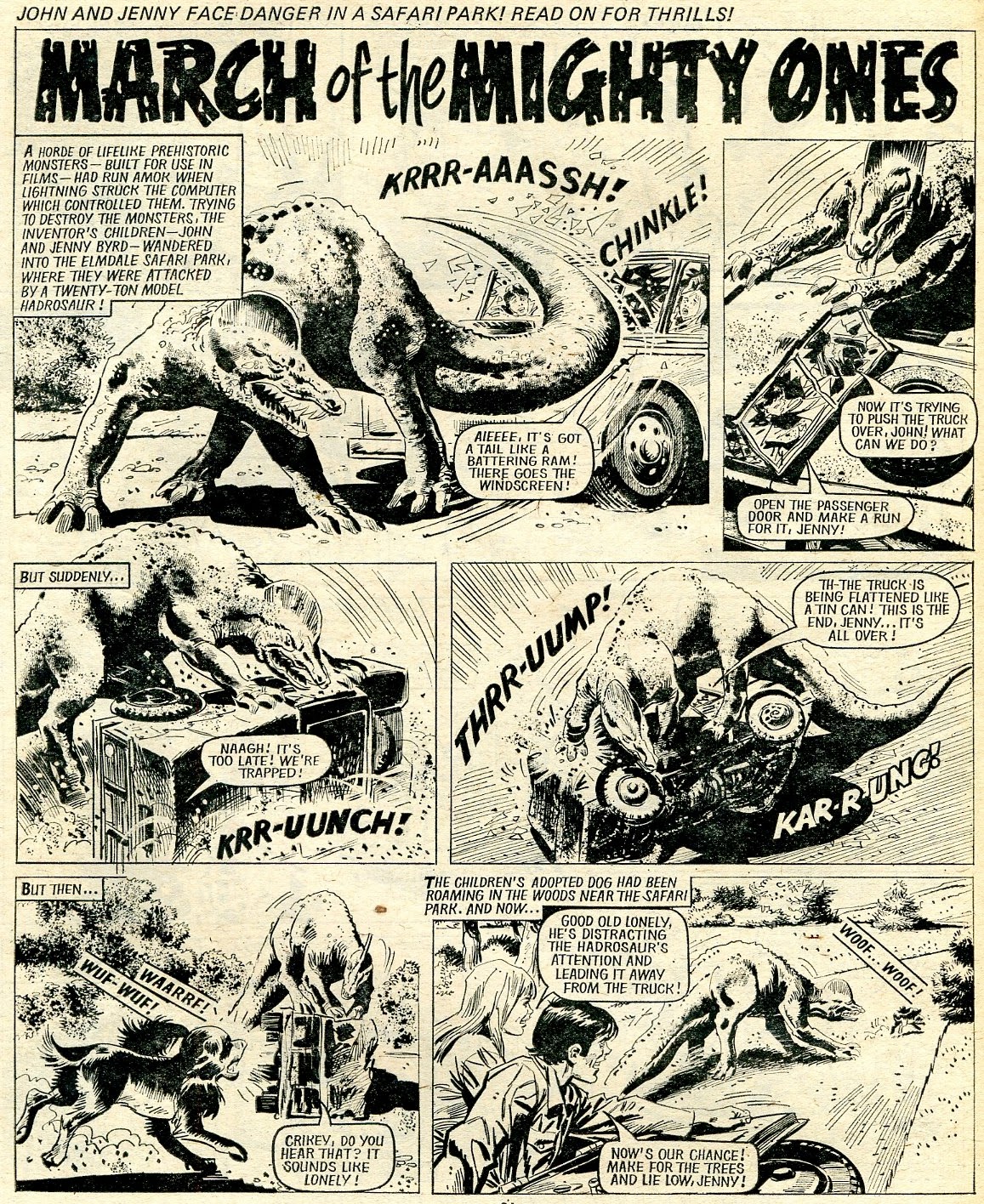1984 SHIVER & SHAKE Annual. The price was still £ 1.95 but
the volume got even slimmer and only had 96 pages. Like in the 1983 Annual, two different kinds of paper were used - quality white paper for sections with colour pages and pulp paper for the middle section of the book.
Contents: Wacky
Winter Sports (in full colour by Terry Bave), Webster (2 sets by Terry
Bave), Sweeny Toddler (2 sets by Tom Paterson, one in full colour), Blunderpuss
(2 sets by Terry Bave, one in full colour), Castle
Cackle (3 instalments), The Duke’s Spook (2 sets, one in
full colour), Horrornation Street (2 sets by Jim Crocker, one in full colour),
Shake
(4 sets, two in full colour by Mike Lacey, all are reprints), ‘Orrible
Hole (2 sets, one in full colour by Crocker), Lolly Pop (2 new sets: a 4-pager
and a 3-pager by Sid Burgon), The Desert Fox (by Terry Bave), Shake’s
Jumbo Jests (gags by Crocker), The Forest Legion (a 4-pager), Tough
Nutt and Softy Centre (2 sets by Norman Mansbridge, one definitely a reprint),
Frankie
and the Beanstalk (a 5-page tale by Brian Walker), Sports School (2 sets by
Jim Watson), The Hand (by Les Barton), Grimly Feendish (2 sets signed by
Swotts), Ghoul Getters Ltd. (2 sets by Trevor Metcalfe from SHIVER AND
SHAKE Nos. 73 and 77, one coloured-in), Shiver and Shake’s Diamond Dungeon Game
(by J. Edward Oliver), Moana Lisa (2 sets by Peter Davidson,
one in full colour), Shiver’s Posts For Ghosts (text
story with illustrations by Crocker), Ghouldilocks (2 reprints, art by
Stan McMurtry), The Hand Presents Me and My Shadow, Toby’s Timepiece (a
5-pager by Ron Turner), Shake’s Picture Posers (spot-the-difference
puzzle, reuses an old ShSh cover), The Ghost’s Revenge (4 pages by I
don’t know who), Shiver’s Ghostly Giggles (gags by Crocker), Frankie
Stein (4 pages by Brian Walker), Shiver (by Terry Bave).
Upon opening
the book we find a busy colourful winter sports scene with lots of SHIVER AND
SHAKE characters, all drawn by Terry Bave:
With 10
pages of artwork, Terry Bave was the biggest contributor, followed closely by Brian
Walker and Jim Crocker (9 pages each). The latter substituted the regular
artist Tom Williams on both Horrornation Street episodes in this
Annual:
The Forest
Legion got a new artist but I don’t know the name. It is the first
ever episode without Boss and Butch who are probably spending their days in
jail since their last adventure in the previous Annual… This time Winnie the Witch treats
the legionnaires to some magic buns and turns them into her slaves so that they
do all the chores for her. Mole is the smart one who doesn’t eat his bun; he
uses a spell from the Witch’s spell-book against her and makes the nasty old woman lift her
spell from his mates.

There are
two Frankie Stein stories in the Annual, both illustrated by Brian Walker. In Frankie
and the Beanstalk Prof. Cube tries out his new plant food and grows a
giant beanstalk. He causes grand-scale disaster when he chops it down as
Frankie climbs to the top hoping to find the goose that lays golden eggs. The
beanstalk is so tall that Frankie hits the ground in France and the beanstalk
disrupts maritime transport across the English Channel. Frankie crosses the
Channel back to England and returns home where an accidental spill of the plant
food turns him into a giant…
In the
second story Dad has to buy a new set of furniture because Frankie’s broken
every piece in Mildew Manor but Frankie smashes it again when he tumbles head
over heels down a pile of dirt and into the house after Dad jabs
him with a spade.
 |
Frankie sitting on a pile of dirt
moments before Prof. Cube digs himself
out of it underneath him.
|
Both Grimly Feendish tales were illustrated by a new artist who signed them as Swotts.
In the first episode Grimly plans to “clean up” the town by drowning it in soap-suds
from the local laundry. In the second tale Grimly robs a toy shop but gets into
trouble when he tries to pay for some sweets with Monopoly money. Here are
sample panels from both sets with the artist’s signature:
There are a couple of new features in the Annual. One is Castle
Cackle, drawn and signed by Mitch. Here is one of the three
installments from the book:
It is the first time that a text story is included in a SHIVER AND SHAKE
publication. In a 2-page tale called Shiver’s Posts for Ghosts
the protagonist (Shiver the spook) tells us about his efforts to earn himself some
cash by standing in for other ghosts while they go on holiday. Check out the
first page of the feature below. Jim Crocker provided illustrations.
I would also like to mention Shiver and Shake’s Diamond Dungeon
game drawn and signed by J.Edward Oliver:
As usual, I’ve saved my personal highlight for the end of the blogpost. I
am not a fan of Toby’s Timepiece but this time I find the story quite good. Ron
Turner’s artwork makes it even better. Here it is in full:

































